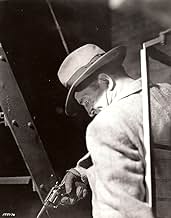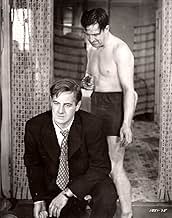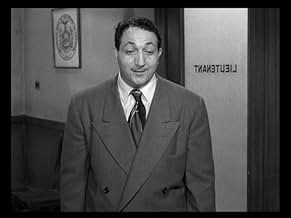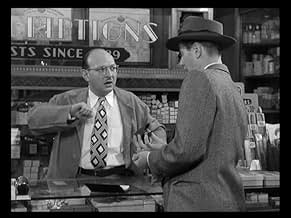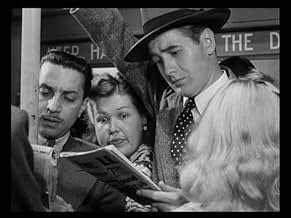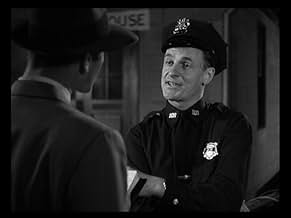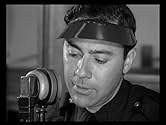IMDb रेटिंग
7.5/10
16 हज़ार
आपकी रेटिंग
न्यूयॉर्क की सड़कों पर हत्या की जांच पर एक कदम-दर-चरण नज़र।न्यूयॉर्क की सड़कों पर हत्या की जांच पर एक कदम-दर-चरण नज़र।न्यूयॉर्क की सड़कों पर हत्या की जांच पर एक कदम-दर-चरण नज़र।
- 2 ऑस्कर जीते
- 6 जीत और कुल 5 नामांकन
Ted de Corsia
- Willy Garzah
- (as Ted De Corsia)
Mark Hellinger
- Narrator
- (वॉइस)
Jean Adair
- Little Old Lady
- (बिना क्रेडिट के)
Celia Adler
- Dress Shop Proprietress
- (बिना क्रेडिट के)
Janie Alexander
- Girl
- (बिना क्रेडिट के)
Joyce Allen
- Shopgirl
- (बिना क्रेडिट के)
Beverly Bayne
- Mrs. Stoneman
- (बिना क्रेडिट के)
फ़ीचर्ड समीक्षाएं
Can film noir work in broad daylight - surely a contradiction in terms..? Well, here, it's attempted and largely pulled off by director Jules Dassin with a down-to-earth almost documentary realism which fully involves the viewer in the action as the well-known tag-line "1 of 8,000,000 stories" (the murder of a pretty female immigrant who's fallen into bad company and criminal habits) is played out over a three-day period in a sunny summery New York cityscape. William Daniels' excellent photography captures a city constantly on the move with its own citizens as accidental extras and actual locations as would-be film-sets. Just as effective is the natural vernacular dialogue with some great one-liners thrown in - none better than Barry Fitzgerald seemingly admiring the rear view of a retreating beautiful female suspect with the remark to a junior colleague "Beautiful long legs she has, wouldn't you say?" to which the underling readily concurs only for old pro Fitzgerald to snap "Keep them in sight for the next 48 hours!" detailing a tail on her. There's also another great scene where the murdered girl's mother berates to all and sundry her dead daughter for her reckless lifestyle and bringing of shame onto her family right up until she is taken to identify the corpse where she breaks down uncontrollably, her maternal feelings restored. The murder tale is slightly convoluted but reasonably easy to follow, no contrived clever-clever plotting here, just an everyday relatively uncomplicated murder, solved by routine police work which makes the headlines due to the beauty of the victim. There's close attention paid to forensics and even the insertion of scenes where perennial sad hoaxers come forward to either claim to solve the murder or even confess to it. The acting is mostly good, Fitzgerald is dapper and spot-on as the world-weary 'tec and his supporting officers all acquit themselves well too. The playing however of some of the criminals gets a little overwrought at times and jars the mood slightly. The film arrives at a reasonably exciting conclusion high above Williamsburg Bridge before the city goes back to sleep awaiting its next story... All done and dusted in 90 very watchable minutes, this is a very entertaining film-blanc I suppose you'd have to call it.
There were quite a few reasons for wanting to see 'The Naked City'. Like Barry Fitzgerald in a lot of other films ('And Then There Were None' being my introduction to him and still consider his performance in that one of his best), though it was interesting to see him in a lead role rather than his relative usual supporting roles and an atypical one at that. Really like what has been seen so far of Jules Dassin's work, especially 'Night and the City'. Also wanted to see whether the film lived up to its highly influential reputation.
Good news is mostly 'The Naked City' does. One can see why 'The Naked City' was influential in its documentary style, which at the time and even by today's standards innovative, and how it is treated in a way that is driven by its characters and with an emphasis on the police and how they worked. And that makes it a highly interesting film and elevates that is fairly conventional, with familiar genre tropes, in the story department. Yet still makes a gripping film regardless of that.
Not many problems here, though for my tastes Don Taylor seemed bland and detached, not always looking very comfortable either.
Do think that the narration could have been used less, as some of it did not always feel needed.
Conversely, 'The Naked City' is immaculately photographed and New York, like its own character, is a major star here. The cinematography and editing Oscars were richly deserved. The haunting score adds hugely, as does Dassin's direction. Dassin is highly successful in creating an authentic, audacious and sometimes unsettling visual style. He is equally successful at keeping the story at a controlled, yet never in my mind mannered or tedious, way that sustains the suspense brilliantly.
Loved the layered tautness of the script outside of the narration, while the story is gripping and its intelligence, high suspense and a knockout of a final chase made me able to forgive that it was quite conventional. The opening sequence is a unique one. Outside of Taylor, didn't actually have an issue with the performances. Although an effective Fitzgerald has been widely talked about, on both sides of good and not so good (am in the former camp), for me the best performance came from chilling Ted De Corsia.
In conclusion, very good film and deservedly influential. 8/10
Good news is mostly 'The Naked City' does. One can see why 'The Naked City' was influential in its documentary style, which at the time and even by today's standards innovative, and how it is treated in a way that is driven by its characters and with an emphasis on the police and how they worked. And that makes it a highly interesting film and elevates that is fairly conventional, with familiar genre tropes, in the story department. Yet still makes a gripping film regardless of that.
Not many problems here, though for my tastes Don Taylor seemed bland and detached, not always looking very comfortable either.
Do think that the narration could have been used less, as some of it did not always feel needed.
Conversely, 'The Naked City' is immaculately photographed and New York, like its own character, is a major star here. The cinematography and editing Oscars were richly deserved. The haunting score adds hugely, as does Dassin's direction. Dassin is highly successful in creating an authentic, audacious and sometimes unsettling visual style. He is equally successful at keeping the story at a controlled, yet never in my mind mannered or tedious, way that sustains the suspense brilliantly.
Loved the layered tautness of the script outside of the narration, while the story is gripping and its intelligence, high suspense and a knockout of a final chase made me able to forgive that it was quite conventional. The opening sequence is a unique one. Outside of Taylor, didn't actually have an issue with the performances. Although an effective Fitzgerald has been widely talked about, on both sides of good and not so good (am in the former camp), for me the best performance came from chilling Ted De Corsia.
In conclusion, very good film and deservedly influential. 8/10
In New York, the model Jean Dexter is found dead in the bathtub of her apartment apparently after committing suicide. However, the coroner concludes that she was actually murdered with a simulation of suicide. The experienced Homicide Lieutenant Detective Dan Muldoon (Barry Fitzgerald) initiates his investigations with Detective Jimmy Halloran (Don Taylor) and his team, and the prime suspect becomes Jean's friend Frank Niles (Howard Duff), who he an alibi but tells many lies in his statement.
The director Jules Dassin from the masterpiece "Du Rififi Chez Les Hommes" and "Night and the City" presents "The Naked City" totally filmed in locations of New York City and with actors interacting with common people on the streets like in the Italian Neo-Realism. The introduction is unique, with the credits narrated by the producer Mark Hellinger like in a documentary, and I do not recall any other movie with this characteristic. The screenplay discloses a great detective story, very well acted with Barry Fitzgerald playing a cynical and smart lieutenant and Don Taylor an inexperienced and family man detective. In the conclusion, the narrator tells that this is one of the 8,000,000 stories of the naked city, in a time where New York City had only this population (against more than 20 million inhabitants of the present days). My vote is eight.
Title (Brazil): "Cidade Nua" ("Naked City")
Note: On 27 May 2016, I saw this film again.
The director Jules Dassin from the masterpiece "Du Rififi Chez Les Hommes" and "Night and the City" presents "The Naked City" totally filmed in locations of New York City and with actors interacting with common people on the streets like in the Italian Neo-Realism. The introduction is unique, with the credits narrated by the producer Mark Hellinger like in a documentary, and I do not recall any other movie with this characteristic. The screenplay discloses a great detective story, very well acted with Barry Fitzgerald playing a cynical and smart lieutenant and Don Taylor an inexperienced and family man detective. In the conclusion, the narrator tells that this is one of the 8,000,000 stories of the naked city, in a time where New York City had only this population (against more than 20 million inhabitants of the present days). My vote is eight.
Title (Brazil): "Cidade Nua" ("Naked City")
Note: On 27 May 2016, I saw this film again.
There are two styles of Film Noir. Fueled by writers like James M. Cain, Dashiell Hammett, and Raymond Chandler, the first style emerged in the 1940s and was characterized by a cynical, often witty tone; anti-heroes, dangerous women, and assorted criminal elements; and complex plots that emphasized betrayal and moral ambiguity. It was also photographed in a remarkable visual style that combined glossy production values with atmospheric emphasis on light and shadow--and films like THE MALTESE FALCON, THIS GUN FOR HIRE, MILDRED PIERCE, THE BLUE DAHLIA, and DOUBLE INDEMNITY remain great classics of their kind.
But after World War II public taste began to change. Things that could only be hinted at in earlier films could now be more directly stated, and as audiences clamored for a more gritty realism the glossy sophistication of 1940s Noir fell out of fashion. The result was a new style of Noir--photographed in a grainier way, more direct, more brutal, and even less sympathetic to its characters. And the 1948 THE NAKED CITY was among the first to turn the tide. The sophisticated gumshoe, slinky gun moll, and glossy production values were gone; this film felt more like something you might read in a particularly lurid "true detective" tabloid.
In an era when most films were shot on Hollywood backlots, THE NAKED CITY was actually filmed in New York--and while filmmakers could film with hidden cameras sound technology of the day posed a problem. But producer Mark Hellinger turned the problem into an asset: the film would be narrated, adding to the documentary-like style of the cinematography and story. (Hellinger performed the narrative himself, and his sharp delivery is extremely effective.) The story itself reads very much like a police report, following NYPD detectives as they seek to solve a dress model's murder.
For 1948 it was innovative stuff-but like many innovative films it falters a bit in comparison to later films that improved upon the idea. The direct nature of the plot feels slightly too direct, slightly too simple. The same is true of the performances, which have a slightly flat feel, and although Barry Fitzgerald gives a sterling performance he is very much a Hollywood actor whose style seems slightly out of step alongside the deadpan style of the overall cast. Even so, the pace and drive of the film have tremendous interest, and while you might find yourself criticizing certain aspects you'll still be locked into the movie right to the very end. Particularly recommended for Film Noir addicts, who will be fascinated to see the turning point in the style.
Gary F. Taylor, aka GFT, Amazon Reviewer
But after World War II public taste began to change. Things that could only be hinted at in earlier films could now be more directly stated, and as audiences clamored for a more gritty realism the glossy sophistication of 1940s Noir fell out of fashion. The result was a new style of Noir--photographed in a grainier way, more direct, more brutal, and even less sympathetic to its characters. And the 1948 THE NAKED CITY was among the first to turn the tide. The sophisticated gumshoe, slinky gun moll, and glossy production values were gone; this film felt more like something you might read in a particularly lurid "true detective" tabloid.
In an era when most films were shot on Hollywood backlots, THE NAKED CITY was actually filmed in New York--and while filmmakers could film with hidden cameras sound technology of the day posed a problem. But producer Mark Hellinger turned the problem into an asset: the film would be narrated, adding to the documentary-like style of the cinematography and story. (Hellinger performed the narrative himself, and his sharp delivery is extremely effective.) The story itself reads very much like a police report, following NYPD detectives as they seek to solve a dress model's murder.
For 1948 it was innovative stuff-but like many innovative films it falters a bit in comparison to later films that improved upon the idea. The direct nature of the plot feels slightly too direct, slightly too simple. The same is true of the performances, which have a slightly flat feel, and although Barry Fitzgerald gives a sterling performance he is very much a Hollywood actor whose style seems slightly out of step alongside the deadpan style of the overall cast. Even so, the pace and drive of the film have tremendous interest, and while you might find yourself criticizing certain aspects you'll still be locked into the movie right to the very end. Particularly recommended for Film Noir addicts, who will be fascinated to see the turning point in the style.
Gary F. Taylor, aka GFT, Amazon Reviewer
An unrealized project of Alfred Hitchcock's was to make a movie about 24 hours in the life of a great city, probably New York. Producer Mark Hellinger enlisted director Jules Dassin to attempt a similar stunt. The result was The Naked City, a slice-of-life police procedural that served as template for the popular television series a decade later. And while the movie is nowhere near the ground-breaking cinematic enterprise that Hellinger promises in his introduction and ceaseless voice-over narration, it's not negligible. With its huge cast (many of them recognizable, even in mute or walk-on roles) and pioneering location shooting on the sidewalks of New York during the sweltering summer of 1947, it nonetheless continues to satisfy. Its documentary aspect outlives its suspense plot.
It opens with two men chloroforming and then drowning a high-profile model in her city apartment (shades of I Wake Up Screaming and Laura). When her cleaning lady finds her next morning, it falls to Detective Lieutenant Barry Fitzgerald, with his heather-honey lilt, and his principal investigator, Don Taylor, to fit the pieces together. Soon into their web flits Howard Duff, an affable, educated loafer with no visible means of support who lies even when the truth would do him no harm. It seems he was on cozy terms with the deceased, even though he's engaged to one of her co-workers (Dorothy Hart). But although Duff's a poor excuse for a human being, nothing seems to stick to him, either. So the police slog on through the broiling day and soupy night, knocking on doors and flashing pictures of the dead girl. Their sleuthing takes them, and us, up and down the hierarchy of the city's eight million souls, from society dames and society doctors to street vendors and street crazies.
While the plot never rises out of the routine, these urban excursions give the movie its raffish texture and remain one of its chief pleasures. This was New York in the dawn of its post-war effloresence, a city where it was still common practice to live comfortably on modest average wages. The gap between East Side apartments and Lower East Side walkups, with the bathtub in the kitchen, doesn't yet seem impossible to cross. And its inhabitants burst on camera with a welter of accents and attitudes. Hellinger and Dassin must have enlisted the services of every character-actor and bit-player in the Tri-State area, and film buffs will have a trivia tournament in trying to pick them out.
The Naked City ends with a chase over hot pavements and a stand-off high up on one of the bridges spanning the East River. It's a great set-piece, of the sort that action movies are all but required to include, but the movie's strength proves more subtle it lies in its collection of sharply drawn vignettes (some of them, to be sure, little more than sentimental shtik). The Naked City is a rarity a major production where the day players outshine the stars.
It opens with two men chloroforming and then drowning a high-profile model in her city apartment (shades of I Wake Up Screaming and Laura). When her cleaning lady finds her next morning, it falls to Detective Lieutenant Barry Fitzgerald, with his heather-honey lilt, and his principal investigator, Don Taylor, to fit the pieces together. Soon into their web flits Howard Duff, an affable, educated loafer with no visible means of support who lies even when the truth would do him no harm. It seems he was on cozy terms with the deceased, even though he's engaged to one of her co-workers (Dorothy Hart). But although Duff's a poor excuse for a human being, nothing seems to stick to him, either. So the police slog on through the broiling day and soupy night, knocking on doors and flashing pictures of the dead girl. Their sleuthing takes them, and us, up and down the hierarchy of the city's eight million souls, from society dames and society doctors to street vendors and street crazies.
While the plot never rises out of the routine, these urban excursions give the movie its raffish texture and remain one of its chief pleasures. This was New York in the dawn of its post-war effloresence, a city where it was still common practice to live comfortably on modest average wages. The gap between East Side apartments and Lower East Side walkups, with the bathtub in the kitchen, doesn't yet seem impossible to cross. And its inhabitants burst on camera with a welter of accents and attitudes. Hellinger and Dassin must have enlisted the services of every character-actor and bit-player in the Tri-State area, and film buffs will have a trivia tournament in trying to pick them out.
The Naked City ends with a chase over hot pavements and a stand-off high up on one of the bridges spanning the East River. It's a great set-piece, of the sort that action movies are all but required to include, but the movie's strength proves more subtle it lies in its collection of sharply drawn vignettes (some of them, to be sure, little more than sentimental shtik). The Naked City is a rarity a major production where the day players outshine the stars.
क्या आपको पता है
- ट्रिवियाMost of the street scenes were shot on location in New York without the public's knowledge. Photographer William H. Daniels and his uncredited assistant Roy Tripp filmed people on the streets using a hidden camera from the back of an old moving van. Occasionally, a fake newsstand with a hidden camera inside was also set up on the sidewalk to secretly film the actors. Director Jules Dassin hired a juggler to distract the crowds and also hired a man to occasionally climb up on a light post and give a patriotic speech, while waving an American flag to get the crowd's attention.
- गूफ़During the end pursuit, Garzah walks past a plump, dark-haired lady in a floral dress, pushing a baby in a stroller. As Donahue pursues in a following scene, he passes the same woman, now walking without her baby carriage and her left hand bandaged.
- क्रेज़ी क्रेडिटThe opening credits are spoken by producer/narrator Mark Hellinger. No credits are seen on the screen.
- कनेक्शनFeatured in Visions of Light (1992)
- साउंडट्रैकSobre las Olas (Over the Waves)
(1887) (uncredited)
Written by Juventino Rosas
Background music for the girls on swings
टॉप पसंद
रेटिंग देने के लिए साइन-इन करें और वैयक्तिकृत सुझावों के लिए वॉचलिस्ट करें
- How long is The Naked City?Alexa द्वारा संचालित
विवरण
- रिलीज़ की तारीख़
- कंट्री ऑफ़ ओरिजिन
- भाषा
- इस रूप में भी जाना जाता है
- La ciudad desnuda
- फ़िल्माने की जगहें
- उत्पादन कंपनियां
- IMDbPro पर और कंपनी क्रेडिट देखें
बॉक्स ऑफ़िस
- US और कनाडा में सकल
- $24,00,000
- चलने की अवधि1 घंटा 36 मिनट
- रंग
- पक्ष अनुपात
- 1.37 : 1
इस पेज में योगदान दें
किसी बदलाव का सुझाव दें या अनुपलब्ध कॉन्टेंट जोड़ें



